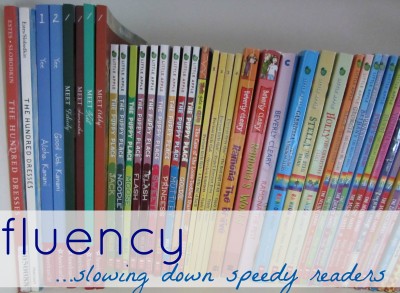 I’ve said before that one of the things that you never want to say to a reader is Slow down! You’re reading too fast! or. . .
I’ve said before that one of the things that you never want to say to a reader is Slow down! You’re reading too fast! or. . .
. . . You’re reading waaaaay too slow. C’mon, pick up the pace so we can get through this, Honey.
It’s just not helpful, and no one feels great saying these things or hearing them. And I think we all know that though those suggestions may be short-term, if kids are slow–or speedy–readers, any time they read aloud, they’re not reading fluently.
The awesome news there are a few other really worthwhile, constructive ways of helping children as you ‘coach’ them into more fluent reading. Everyone wants to be a fluent reader–especially our younger, newer readers.
Here’s the skinny. . .
- Learning During Read-Alouds–Improve Fluency by Slowing Down Speedy Readers: Fluency is a whole lot more than reading at an ‘easy-to-understand’ pace.
According to Timothy V. Rasinski in the May issue of The Reading Teacher, fluency should be HOT! In an article titled just that–and no, I’m not joking–Rasinski says that [his] conception of fluency puts it at the center of authentic reading instruction in which the aim of students’ reading is comprehension (Rasinski, T. V. (2012), Why Reading Fluency Should Be Hot!. The Reading Teacher, 65: 516–522).
He goes on to say that fluency is a critical component of reading instruction and that its two components, automaticity and prosody, are essential to its makeup. No need to freak out about these two ‘biggie’ reading terms, my friends.
Here’s a quickie clip sharing one way I helped Maddy slow down her super-fast reading this year–improving her prosidy by forcing her to slow at end punctuation marks:
‘Automaticity’ just means that readers can recognize words automatically and without effort, which is why we need to practice those sight words and design balance literacy programs that include word work! ‘Prosity’ just means that the reading demonstrates the natural rhythm and intonation of language. Together, automaticity and prosidy make up fluency, so it only makes sense that in order to read fluently, the reader must understand the text.
I’m looking forward to sharing more tips to improve fluency as the year unfolds, but until then, I hope that this little ‘slow down’ trick helps a speedy reader in your life.
What methods do you use to slow down speedy readers? Please share!

I love this idea, Amy! I’ve struggled with helping Quincy develop fluency and pacing- sometimes way too fast, sometimes too slow. I’m thinking this trick will work for my very tactile little boy. 😉 I think having a physical cue to remind him of punctuation could be very helpful. Thanks for sharing and I’ll let you know how it goes!
I place my hand over their hand/arm/leg and softly tap my finger to remind them to pause or if in the middle of a sentence, to go back to correct if. This way i am not saying anything verbal to break the pace.
Lisa–
Great idea–the tactile reminder is so helpful, and you’re right–without breaking the flow is so important. Thanks for sharing, my friend!